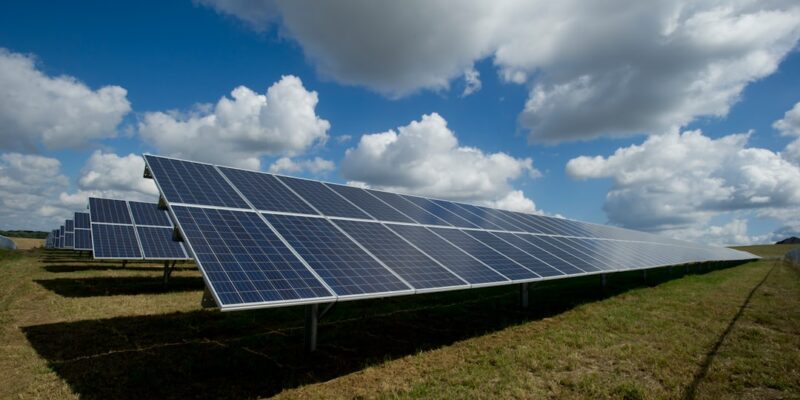
Wave Magnets: The Affordable Solution for Clean Energy
Wave magnets are a revolutionary clean energy solution that has the potential to transform the way we generate electricity. Unlike traditional energy sources such as fossil fuels, wave magnets harness the power of ocean waves to generate clean and renewable energy. This technology has gained significant attention in recent years due to its ability to provide a reliable and sustainable source of electricity.
Key Takeaways
- Wave magnets are a revolutionary clean energy solution.
- Wave magnets work by harnessing the power of ocean waves to generate electricity.
- Wave magnets have advantages over traditional energy sources, including being renewable and non-polluting.
- Wave magnets are cost-effective and affordable for everyone, making them accessible to all.
- Wave magnets have the potential to meet global energy demands and reduce carbon emissions.
Understanding the Science Behind Wave Magnets and How They Work
Wave magnets work by utilizing the kinetic energy of ocean waves to generate electricity. The basic principle behind wave magnets is that when ocean waves pass through a magnetic field, they induce a current in a conductor, which can then be harnessed and converted into usable electricity. This process is similar to how a generator works, but instead of using fossil fuels or other non-renewable resources, wave magnets rely on the natural power of the ocean.
Compared to traditional energy sources such as coal or natural gas, wave magnets have several advantages. Firstly, they are a renewable source of energy, meaning that they will never run out as long as there are waves in the ocean. Secondly, wave magnets do not produce any greenhouse gas emissions or air pollutants during operation, making them a much cleaner option for generating electricity. Lastly, wave magnets have the potential to provide a consistent and reliable source of energy, as ocean waves are constantly in motion.
The Advantages of Wave Magnets over Traditional Energy Sources
One of the main advantages of wave magnets over traditional energy sources is their reliability. Unlike solar or wind power, which can be intermittent depending on weather conditions, ocean waves are constant and predictable. This means that wave magnets can provide a consistent source of electricity without relying on external factors.
Another advantage of wave magnets is their scalability. Unlike fossil fuels, which require large-scale extraction and processing operations, wave magnets can be deployed on a smaller scale and integrated into existing infrastructure. This makes them a more flexible and adaptable solution for meeting energy demands.
In addition to their reliability and scalability, wave magnets also have several environmental benefits. Unlike fossil fuels, which release carbon dioxide and other pollutants when burned, wave magnets produce zero emissions during operation. This makes them a much cleaner option for generating electricity and can help reduce the impact of climate change.
How Wave Magnets are Cost-Effective and Affordable for Everyone
| Benefits of Wave Magnets | Explanation |
|---|---|
| Low Cost | Wave magnets are affordable and cost-effective compared to other renewable energy sources. |
| Easy Installation | Wave magnets can be easily installed in coastal areas without any major construction work. |
| Low Maintenance | Wave magnets require minimal maintenance and have a long lifespan, making them a cost-effective option in the long run. |
| Reliable | Wave magnets are a reliable source of energy as they are not affected by weather conditions and can generate power 24/7. |
| Environmentally Friendly | Wave magnets do not produce any harmful emissions and are a clean source of energy, making them an environmentally friendly option. |
While the initial investment in wave magnet technology may be higher than traditional energy sources, the long-term cost savings associated with wave magnets make them a cost-effective and affordable option for everyone. Once installed, wave magnets have minimal operating costs as they rely on the natural power of the ocean to generate electricity. This means that over time, the cost of generating electricity from wave magnets can be significantly lower than traditional energy sources.
Furthermore, wave magnets have the potential to be made accessible to all communities, regardless of their location or resources. Unlike fossil fuels, which require large-scale infrastructure and transportation networks, wave magnets can be deployed in coastal areas or even offshore, making them accessible to communities near the ocean. This can help reduce energy inequality and provide clean and affordable electricity to communities that may not have access to traditional energy sources.
The Environmental Benefits of Using Wave Magnets for Clean Energy
The environmental impact of traditional energy sources such as coal or natural gas is well-documented. These sources release carbon dioxide and other pollutants into the atmosphere, contributing to climate change and air pollution. In contrast, wave magnets produce zero emissions during operation, making them a much cleaner option for generating electricity.
By using wave magnets for clean energy, we can significantly reduce carbon emissions and other pollutants that contribute to climate change. This can help mitigate the impacts of global warming and create a more sustainable future for generations to come. Additionally, by reducing our reliance on fossil fuels, we can also decrease our dependence on non-renewable resources and protect the environment from the negative impacts of extraction and processing operations.
The Potential of Wave Magnets to Meet Global Energy Demands
Wave magnets have the potential to meet a significant portion of global energy demands. According to estimates, the energy potential of ocean waves is vast, with the ability to generate several terawatts of electricity worldwide. This is equivalent to a significant portion of current global energy consumption.
Compared to other renewable energy sources such as solar or wind power, wave magnets have several advantages. Firstly, they are not dependent on weather conditions, making them a more reliable and consistent source of energy. Secondly, wave magnets can be deployed in coastal areas or offshore, making them accessible to a larger population. Lastly, wave magnets have a smaller environmental footprint compared to other renewable energy sources, as they do not require large-scale land use or produce noise pollution.
Wave Magnets and their Role in Reducing Carbon Emissions
Reducing carbon emissions is crucial in combating climate change and mitigating its impacts. Wave magnets play a significant role in reducing carbon emissions by providing a clean and renewable source of electricity. By replacing traditional energy sources such as coal or natural gas with wave magnets, we can significantly decrease our carbon footprint and contribute to global efforts to reduce greenhouse gas emissions.
Reducing carbon emissions is not only important for mitigating climate change but also for protecting human health and the environment. Carbon dioxide and other pollutants released by traditional energy sources contribute to air pollution, which can have detrimental effects on human health and ecosystems. By transitioning to wave magnets for clean energy, we can improve air quality and create a healthier and more sustainable environment for all.
The Future of Wave Magnets: Innovations and Advancements
The future of wave magnet technology looks promising, with ongoing research and development efforts aimed at improving efficiency and reducing costs. Innovations such as new materials, improved designs, and advanced control systems are being explored to enhance the performance of wave magnets and make them more economically viable.
One area of research is focused on increasing the efficiency of wave magnets by optimizing the design and placement of the devices. By understanding the behavior of ocean waves and their interaction with wave magnets, researchers can develop more efficient systems that can generate more electricity from the same amount of wave energy.
Another area of research is focused on reducing the costs associated with wave magnet technology. This includes exploring new manufacturing techniques, materials, and construction methods that can lower the overall cost of deploying wave magnets. Additionally, advancements in energy storage technologies can help address the intermittent nature of wave energy and make it more reliable for meeting energy demands.
Wave Magnets in Action: Success Stories and Real-World Applications
Wave magnets are already being used in real-world applications around the world. One example is the European Marine Energy Centre (EMEC) in Orkney, Scotland, which serves as a test site for wave magnet technology. The EMEC has been instrumental in advancing wave magnet technology and has attracted companies from around the world to test their devices in real-world conditions.
Another success story is the Wave Hub project in Cornwall, England. The Wave Hub is a grid-connected offshore facility that allows wave magnet developers to test their devices and generate electricity for the local grid. The project has attracted several companies and has helped accelerate the development and deployment of wave magnet technology.
These success stories demonstrate the potential of wave magnets as a viable and scalable clean energy solution. By showcasing real-world applications and proving the reliability and effectiveness of wave magnet technology, these projects are paving the way for wider adoption and integration into existing energy systems.
Why Wave Magnets are the Key to a Sustainable Future
In conclusion, wave magnets have the potential to revolutionize the way we generate electricity and provide a sustainable solution for meeting global energy demands. With their reliability, scalability, and environmental benefits, wave magnets offer a clean and renewable alternative to traditional energy sources.
Investing in wave magnet technology is crucial for creating a sustainable future. By reducing our reliance on fossil fuels and transitioning to clean energy sources such as wave magnets, we can significantly reduce carbon emissions, mitigate climate change, and protect the environment. Additionally, wave magnets have the potential to provide affordable and accessible electricity to all communities, regardless of their location or resources.
As research and development efforts continue to advance wave magnet technology, we can expect to see further innovations and advancements in the field. With ongoing improvements in efficiency and cost-effectiveness, wave magnets are poised to become a mainstream clean energy solution that can help create a more sustainable and resilient future for generations to come.
FAQs
What are wave magnets?
Wave magnets are a type of technology that harnesses the power of ocean waves to generate electricity. They consist of a series of magnets that move back and forth as waves pass over them, creating an electrical current.
How do wave magnets generate electricity?
Wave magnets generate electricity through the process of electromagnetic induction. As the magnets move back and forth, they create a magnetic field that induces an electrical current in nearby coils of wire.
What makes wave magnets a clean energy source?
Wave magnets are a clean energy source because they do not produce any greenhouse gas emissions or other pollutants. They also do not require any fuel to operate, making them a sustainable and renewable source of energy.
How efficient are wave magnets at generating electricity?
Wave magnets have the potential to be highly efficient at generating electricity, with some estimates suggesting that they could achieve efficiencies of up to 90%. However, the technology is still in the early stages of development and more research is needed to optimize its performance.
What are the advantages of using wave magnets for energy generation?
Wave magnets offer several advantages over other forms of energy generation, including their low cost, high efficiency, and minimal environmental impact. They also have the potential to provide a reliable source of energy in coastal areas where waves are consistently strong.

















